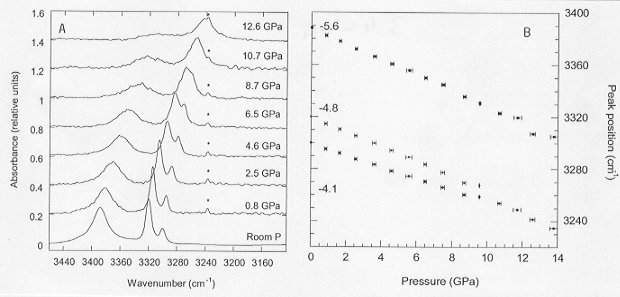

To study OH in minerals or melts, infrared spectroscopy is a very useful technique, especially because it allows in-situ investigations as a function of pressure and temperature. In-situ measurements are particularly important, as trace amounts of hydrogen can drastically affect the transport properties of minerals of the Earth's mantle. These effects can only be understood if the speciation of OH in mantle minerals at high P and T is known.
Single crystals of MgSiO3-ilmenite (akimotoite) containing about 3900 H/106 Si (˜1400 ppm H2O) were synthesised at 19 GPa and 1300°C in a multianvil apparatus. The polarized IR spectra (see Annual Report 1997) show five pleochroic bands, consistent with hydroxyl groups occuring as point defects in the structure. High-pressure FTIR measurements were performed up to 14 GPa using a Merrill Bassett diamond anvil cell, with nitrogen as a hydrostatic pressure transmitting medium. Pressure was measured using the ruby fluorescence technique. Some representative IR spectra of MgSiO3-ilmenite recorded during compression are shown in Figure 3.4-14.
 |
Fig. 3.4-14: (A) Unpolarised FTIR spectra and (B) OH stretching frequencies as a function of pressure for MgSiO3-ilmenite. * indicates a band arising from the diamonds in the cell. The numbers indicated in (B) are the values for the pressure derivative of the frequency, dv/dP, in cm-1/GPa. |
Upon compression the OH bands shift towards lower frequencies, consistent with a decrease in the force constant of the OH bond in a hydrogen bonded system. At about 9 GPa, the two low frequency bands merge, suggesting that these bands represent the same type of hydrogen and that the band splitting observed at room pressure is due to ordering of the proton position upon decompression. The absolute value of the pressure derivative of the OH stretching frequency, |dv / dP| (see Fig. 3.4-14), increases with increasing initial wavenumber. According to the correlation between OH stretching frequency and O-H···O distances, this implies that the proton site corresponding to the 3388 cm-1 band is more compressible than the proton site corresponding to the 3300 cm-1 band. Polarized IR spectra show that the band at 3388 cm-1 is strongly polarized parallel to the c-axis, whereas the band at 3300 cm-1 is strongly polarized perpendicular to the c-axis. The pleochroism of the 3320 cm-1 band is intermediate between these two extremes with 35% of the absorption parallel to the c-axis. On the other hand, the compression of MgSiO3 ilmenite is anistropic with the c axis being twice as compressible as the a axis. Thus the increase of |dv / dP| versus wavenumber is consistent with an increasing component of the OH bond parallel to the more compressible c-axis. The ratio of |dv / dP| between the 3390 and 3300 cm-1 band is not equal to the 2:1 ratio in compressibility between the c and a axis of the ilmenite structure, because this represents net effects that involve the compression of several octahedral layers, some of which are vacant. Instead, |dv / dP| reflects the compressibility of the individual proton sites.
The effect of temperature in a hydrogen bonded system is expected to be the opposite of the effect of pressure. Thus, we plan to perform low temperature experiments on MgSiO3-ilmenite in order to combine both effects of pressure and temperature on the OH stretching vibrations.

Tel: +49-(0) 921 55 3700 / 3766, Fax: +49-(0) 921 55 3769, E-mail: bayerisches.geoinstitut(at)uni-bayreuth.de
 Previous page
Previous page